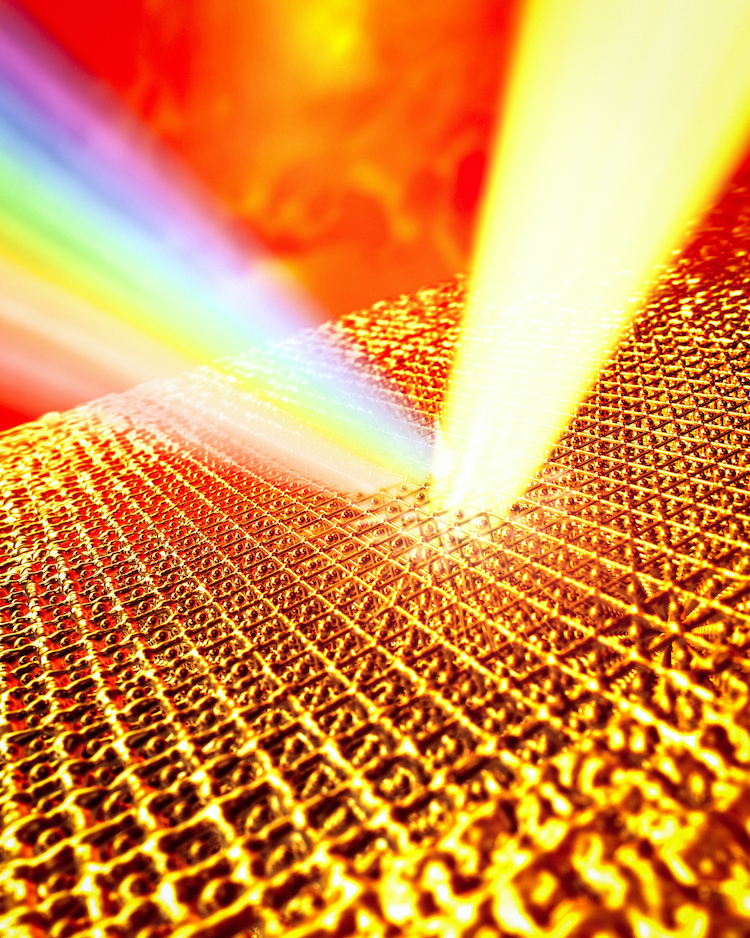Science
Scientists Push Boundaries of Solid Materials’ Melting Points

Researchers at the University of Nevada have uncovered groundbreaking findings regarding the melting points of solid materials. In a study published in Nature, they demonstrated that gold can remain solid at temperatures exceeding its melting point by more than 14 times, challenging previously held theories about the limits of solid-state physics.
The research team, led by Thomas White, utilized high-resolution inelastic X-ray scattering to conduct their experiments. Traditionally, it was believed that solids could not exist at temperatures greater than three times their melting points, a concept referred to as the “entropy catastrophe.” However, the new findings indicate that under rapid heating conditions, this limit can be entirely bypassed.
In their experiments, the researchers heated a 50-nanometre-thick film of gold using intense laser pulses lasting just 50 femtoseconds. The approach enabled them to achieve heating rates exceeding 1015 K s-1, ultimately raising the temperature of the gold to 14 times its melting temperature of 1064 °C. This result far exceeds the previously predicted boundary of the entropy catastrophe, which was thought to occur around 3000 °C.
To accurately measure such extreme temperatures, the team employed the Linac Coherent Light Source (LCLS) at Stanford University. This advanced facility acted as an ultrabright X-ray thermometer. The technique involved atoms or molecules absorbing photons from an X-ray laser at one frequency and re-emitting them at a different frequency, which allowed the researchers to determine the sample’s temperature based on the Doppler shift of the emitted photons.
White explained, “This approach bypasses the need for complex computer modelling because we simply measure the velocity distribution of atoms directly.” The research team, which included scientists from the UK, Germany, and Italy, aimed to establish a direct, model-independent method for measuring atomic temperatures in extreme conditions.
The technical challenges were considerable. White noted, “We not only needed a high-resolution X-ray spectrometer capable of resolving energy features of just millielectronvolts (meV) but also an X-ray source bright enough to generate meaningful signals from small, short-lived samples.”
Typically, temperature measurements under extreme conditions rely on indirect inferences, which often introduce significant uncertainties. “In our experiments, these extreme states last just picoseconds or nanoseconds,” White added. “We can’t exactly insert a thermometer.” This limitation has hindered advancements across plasma and materials physics.
The implications of this research are vast. As White articulated, “Our work provides the first direct method for measuring ion temperatures in dense, strongly driven matter, unlocking new possibilities in areas like planetary science.” This advancement allows for deeper exploration of conditions within giant planets and enhances temperature diagnostics critical for fusion energy research.
The team is now applying their method to shock-compressed materials. White mentioned, “Just a few weeks ago, we completed a six-night experiment at the LCLS using the same high-resolution scattering platform to measure both particle velocity and temperature in shock-melted iron.”
This marks a significant leap forward, as the researchers are now capable of tracking temperatures in both solid and molten states under dynamic compression, akin to conditions found inside planetary interiors.
Looking ahead, White expressed optimism about the future of their research. “Ultimately, our goal is to extend this approach to a wide range of materials and conditions, allowing for a new generation of precise, real-time diagnostics in extreme environments,” he stated.
This innovative work not only challenges existing theories but also sets the stage for potential advancements in materials science, paving the way for studies into the stability limits of solids when subjected to extreme conditions.
-

 Health3 months ago
Health3 months agoNeurologist Warns Excessive Use of Supplements Can Harm Brain
-

 Health3 months ago
Health3 months agoFiona Phillips’ Husband Shares Heartfelt Update on Her Alzheimer’s Journey
-

 Science1 month ago
Science1 month agoBrian Cox Addresses Claims of Alien Probe in 3I/ATLAS Discovery
-

 Science1 month ago
Science1 month agoNASA Investigates Unusual Comet 3I/ATLAS; New Findings Emerge
-

 Science4 weeks ago
Science4 weeks agoScientists Examine 3I/ATLAS: Alien Artifact or Cosmic Oddity?
-

 Entertainment4 months ago
Entertainment4 months agoKerry Katona Discusses Future Baby Plans and Brian McFadden’s Wedding
-

 Science4 weeks ago
Science4 weeks agoNASA Investigates Speedy Object 3I/ATLAS, Sparking Speculation
-

 Entertainment4 months ago
Entertainment4 months agoEmmerdale Faces Tension as Dylan and April’s Lives Hang in the Balance
-

 World3 months ago
World3 months agoCole Palmer’s Cryptic Message to Kobbie Mainoo Following Loan Talks
-

 Science4 weeks ago
Science4 weeks agoNASA Scientists Explore Origins of 3I/ATLAS, a Fast-Moving Visitor
-

 Entertainment4 months ago
Entertainment4 months agoLove Island Star Toni Laite’s Mother Expresses Disappointment Over Coupling Decision
-

 Entertainment3 months ago
Entertainment3 months agoMajor Cast Changes at Coronation Street: Exits and Returns in 2025









